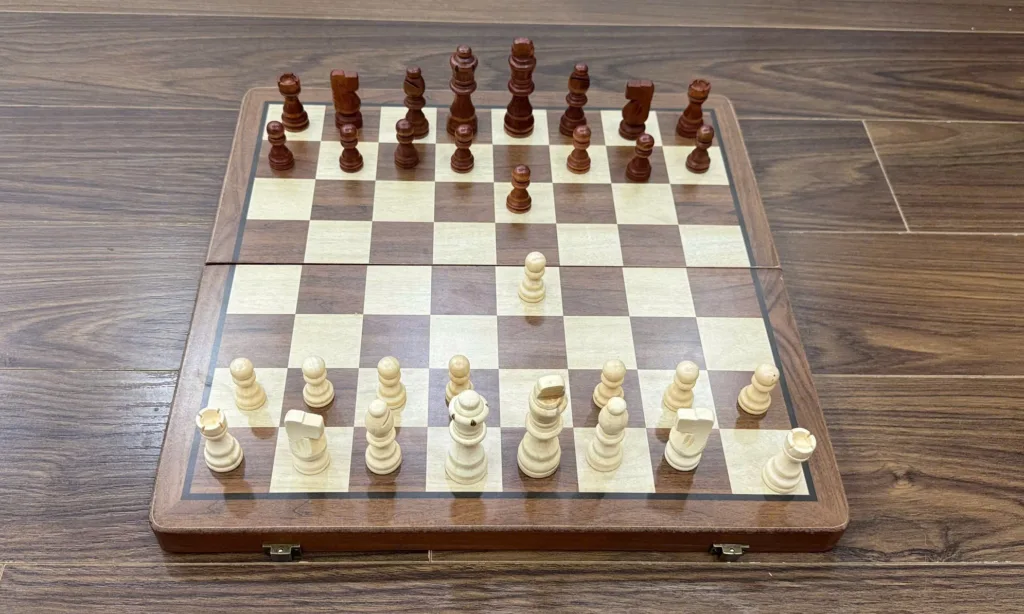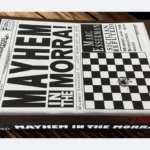Discover the French Defense – an opening of hidden power, central tension, and explosive counterplay. Learn its plans, traps, and key variations.
It starts:
1. e4 e6
2. d4 d5
- Opening Chatter
- The Crossroads on Move 3
- What’s Really Going On?
- White’s To-Do List:
- Black’s Blueprint:
- Key Variations
- The Greek Gift Sacrifice
Opening Chatter
White mutters:
“Really? That’s your idea of an opening? You’ve locked up your c8 bishop tighter than a bank vault. Looks like you’re planning to defend all game.”
Black replies:
“Defend? No. I’m building pressure. My pieces, my pawns,… everything will crash into your center. You built a pretty house, sure. But it’s made of straw, and I’m about to bring the storm.”
The Crossroads on Move 3
White now faces a decision. What to do about the tension in the center?
- Exchange it: exd5 – The Exchange Variation. It levels the playing field and tones down the tension. Safe? Yes. Inspiring? Not exactly.
- Push it: e5 – The Advance Variation. Ambitious, yes. Popular among juniors, yes. But Black knows the terrain here.
- Defend it: Nc3 – the main line, or Nd2 – the Tarrasch Variation. These are the moves of those who aim to fight, and win, the central war.
What’s Really Going On?
The French Defense is a fight for control of the central dark squares, particularly d4 and e5.
- If White keeps command, the position favors him.
- If Black seizes those key points, he’ll free his position, mobilize his forces, and eventually dominate.
When White plays e5, a pawn chain forms. This structure is the heart of the French. And every heart has its weak spots.
Black’s main plan? Break the chain with c5 and later f6, but only once it’s safe.
White’s To-Do List:
- Get your light-square bishop out onto the b1–h7 diagonal early. Don’t trade it if you can help it, it’s a star piece.
- If Black’s slow to develop, start pushing: f4, then f5.
- If Black’s bishop stays home, consider Qd1–g4 to stir up threats.
- Don’t rush c2–c4 or c3–c4 if Black’s bishop is still active, it may help him more than you.
- If you give up your e5 pawn, try to put a piece on that square.
- Likewise, if your d4 pawn is gone, fight to plant something solid there.
Black’s Blueprint:
- Get in c5 fast, but watch out for Nb5–d6, an annoying knight outpost.
- Play f6 – but only after castling. Premature aggression here can backfire fast, especially against Bd3 + Qh5 ideas.
- Think before you capture: both c5xd4 and c5–c4 release central pressure.
- That stuck c8 bishop? Trade it! Try b6 + Ba6.
- Look to swap pieces when you’re cramped. It makes your position breathe.
- If the center locks up, counterattack on the side opposite your king.
Key Variations
THE ADVANCE VARIATION
- e4 e6
- d4 d5
- e5 c5
- c3 Nc6
- Nf3 Qb6
Black immediately targets b2, discouraging Bc1 development. Now White can:
- Play Be2: quiet and solid.
- Try Bd3: sacrificing a pawn to steal momentum.
- Push a3, aiming to soften the queenside with b4.
THE CLASSICAL VARIATION
- e4 e6
- d4 d5
- Nc3 Nf6
- Bg5 Be7
- e5 Nfd7
- Bxe7 Qxe7
White trades his worst bishop for Black’s best. Now comes f4, preparing a strong kingside structure. Black can’t hit back with c5 yet, not with Nb5 looming. Options? Castle or play a6, then try again.
THE STEINITZ VARIATION
- e4 e6
- d4 d5
- Nc3 Nf6
- e5 Nd7
- f4 c5
- Nf3 Nc6
A heavyweight fight. White builds a fortress on e5. Black hammers d4 again and again. White must now hold the line, usually with Be3.
THE WINAWER VARIATION
- e4 e6
- d4 d5
- Nc3 Bb4
Black pins the knight, hoping to snag e4. White says “no thanks” and pushes:
- e5 c5
- a3 Bxc3+
- bxc3 Ne7
Now comes the fork in the road:
- Nf3 for steady growth
- or Qg4, eyeing the g7 pawn and looking to rip open Black’s kingside.
THE TARRASCH VARIATION
- e4 e6
- d4 d5
- Nd2 Nf6
- e5 Nd7
- c3 c5
White avoids the Bb4 pin and supports the center. He can now aim for:
- A solid structure with f4
- Or challenge Black’s push with timely pawn trades
Either way, Nf3 and Ne2 are on deck to support the center.
The Greek Gift Sacrifice
Here’s a warning. Ignore it, and you’ll regret it:
This is the Greek Gift Sacrifice, and every French Defense player, White or Black, must know it.
A bishop sack on h7, followed by a knight invasion and queen swing, ends games. Fast.
How to Defend Against the Greek Gift Sacrifice
The Greek Gift Sacrifice looks flashy, and when it works, it really works. But here’s the truth: most of the time, it doesn’t.
In practical games, especially at lower levels, it’s often played unsoundly. That means your opponent sacrifices a bishop on h7 hoping for a quick mate, but didn’t calculate deeply enough. If you can take the bishop and survive the attack, you’ve just won a free piece.
So how do you know whether to take the bishop or not?
Step 1: Check if you can defend h7/h2.
This is the square everything hinges on. After Bxh7+, if your knight can’t reach f6 (or f3 for White), or if your bishop or queen can’t cover the diagonal, then your king might get stuck in a mating net. Be especially careful if you’ve pushed the f-pawn, it often weakens those critical squares.
Step 2: If the sac is sound, don’t take it.
Sometimes the best defense is to not accept the gift. Declining the sacrifice, by sidestepping the king or prepping a defensive piece—is often safer if you spot that everything lines up for the attacker.
Step 3: If you do take and you’re in danger, start running.
Let’s say you took the bishop, but now there’s no clean way to defend h7/h2. Your best bet? Walk the king out. Seriously. Start stepping it forward (like Kg8–g6–f5–e4…) and look for a route back to safety. It won’t be pretty, you’ll almost certainly have to give up material—but it’s better than getting checkmated.
Preventing the Sacrifice
If you recognize that a Greek Gift is almost working for your opponent, but hasn’t happened yet, you can sometimes shut it down with an early …h6 (or h3 as White). But be careful, this creates a “hook” that your opponent can later use to open lines with g4/g5 or h4/h5. Use it with caution.
Final Thought:
The French Defense is like a fortress. At first glance, it’s slow. Constrained. Defensive.
But in truth? It’s a coiled spring, ready to unspool with explosive energy.
Whether you’re defending with rock-solid structure or launching a slow-burning attack, this opening teaches patience, precision, and the art of delayed violence.
You’re not dodging the fight.
You’re preparing to win it.

I’m Xuan Binh, the founder of Attacking Chess, and the Deputy Head of Communications at the Vietnam Chess Federation (VCF). My chess.com and lichess rating is above 2300. Send me a challenge or message via Lichess. Follow me on Twitter (X) or Facebook.







2 thoughts on “Don’t Be Fooled, The French Defense Hits Hard”
Comments are closed.